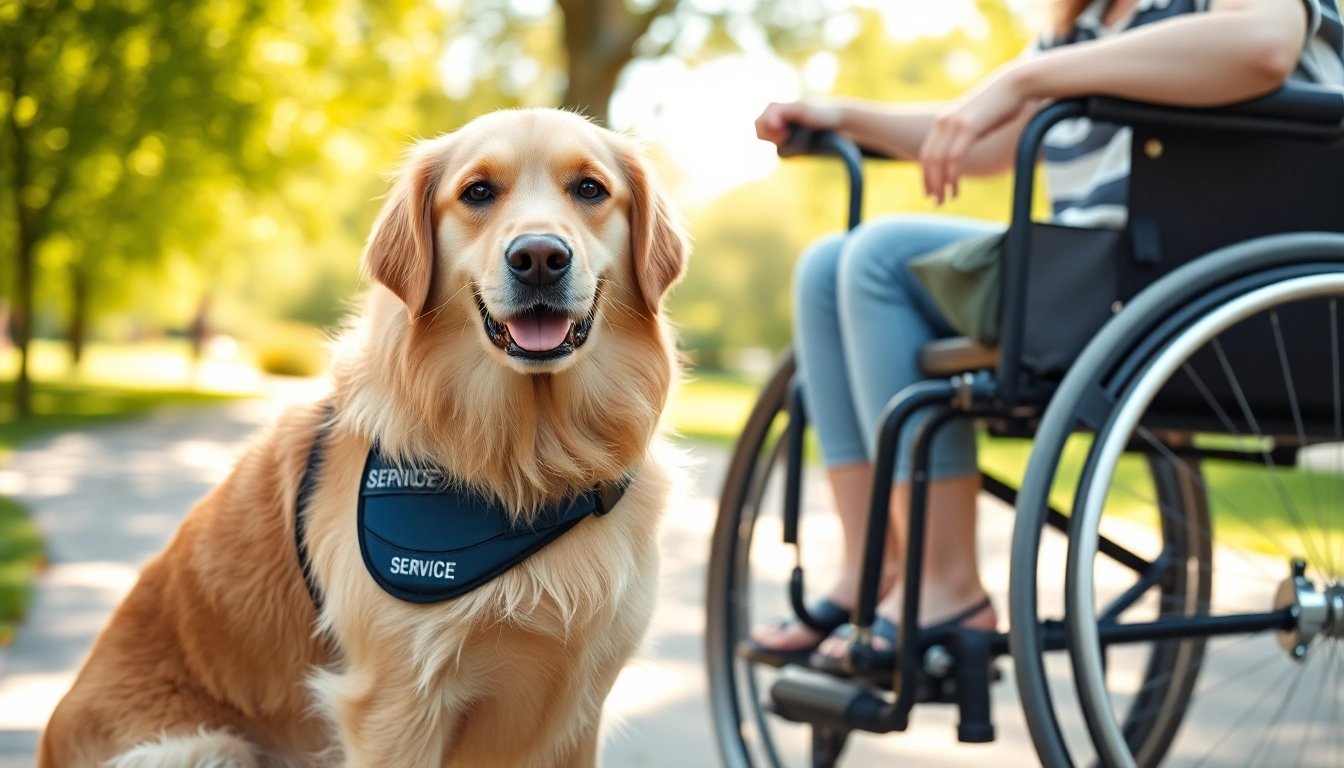Understanding Service Dogs
What is a Service Dog?
A service dog is a highly-trained animal that performs specific tasks to assist individuals with disabilities. Unlike emotional support animals and therapy dogs, service dogs are trained to perform duties directly related to a person’s disability, which may include guiding a blind person, alerting someone who is deaf, or providing support for individuals with mobility challenges. The Americans with Disabilities Act (ADA) recognizes service dogs as working animals and grants them access to public spaces where they can assist their human companions. To effectively get a service dog, one must understand their legal rights, responsibilities, and the process involved in obtaining one.
Different Types of Service Dogs
There are various types of service dogs, categorized based on the specific needs of the individual they assist:
- Guide Dogs: These dogs assist people who are blind or visually impaired by providing navigation support.
- Hearing Dogs: Trained to alert individuals who are deaf or hard of hearing to specific sounds, such as doorbells or alarms.
- Mobility Assistance Dogs: Help individuals with physical disabilities navigate their environment, retrieve items, or provide stability while walking.
- Medical Alert Dogs: Trained to recognize specific medical changes, such as drops in blood sugar or impending seizures, and alert their handlers.
- Psycho-social Support Dogs: Assist individuals with mental health conditions by providing comfort and emotional support, helping mitigate the effects of anxiety, PTSD, and depression.
Recognizing Service Dog Qualities
Service dogs possess specific qualities that make them suitable for their roles, including:
- Temperament: A calm and steady temperament is essential. Service dogs must remain focused and relaxed in various environments.
- Intelligence: Higher-than-average intelligence facilitates learning complex commands and tasks.
- Socialization: Service dogs must be well-socialized, comfortable around people, and able to interact peacefully with other animals.
- Training: Extensive training is mandatory. This includes general obedience and specific task training related to the handler’s disability.
Eligibility to Get a Service Dog
Qualifying Disabilities for Service Dogs
Not all disabilities qualify an individual to receive a service dog. Typically, service dogs are provided for physical and mental health conditions that significantly impair daily functions. Conditions commonly associated with granting a service dog include:
- Vision impairments – such as blindness or significant loss of sight.
- Hearing loss – necessitating alerts for critical sounds.
- Mobility challenges – requiring assistance for balance, walking, or wheelchair navigation.
- Seizure disorders – where dogs can recognize the onset of a seizure.
- Mental health disorders – including PTSD, anxiety disorders, and severe depression, where dogs can provide emotional support.
Documenting Your Need for a Service Dog
To qualify for a service dog, individuals often need documentation from a licensed healthcare professional. This documentation usually states the specific disability and how a service dog would aid in managing that condition. Following steps to ensure proper documentation include:
- Schedule an appointment with a healthcare professional who understands service animals.
- Discuss your daily struggles and how a service dog can alleviate these challenges.
- Request a formal letter outlining your need for a service dog.
Assessing Personal Readiness for a Service Dog
It’s crucial to assess whether you are personally prepared to handle the responsibilities that come with owning a service dog. Important factors that require consideration include:
- Time Commitment: Service dogs require daily care, exercise, and training.
- Financial Responsibility: Owning a dog involves costs such as veterinary care, food, grooming, training, and equipment.
- Physical Capability: You must be physically able to manage and care for a service dog, including taking it on walks and monitoring its behavior.
- Emotional Readiness: Be prepared to provide the necessary support and love the dog requires in return.
Finding the Right Service Dog
Researching Service Dog Organizations
Identifying reputable organizations that train and place service dogs is critical. Organizations often specialize in various types of service dogs, making it essential to find one that aligns with your specific needs. Steps to find a suitable organization include:
- Research organizations online, focusing on reviews and testimonials from past recipients.
- Verify the organization’s credentials and whether they adhere to the Guidelines set forth by Assistance Dogs International (ADI).
- Contact the organization for initial inquiries and assess their responsiveness and willingness to assist.
Connecting with Local Training Programs
Many regions offer local training programs that can help you understand the process of getting and training a service dog. Engaging with local programs may include:
- Attending awareness seminars or workshops focused on service dogs.
- Meeting with trainers to discuss the training process and ask questions concerning your specific needs.
- Connecting with individuals who have gone through similar experiences for first-hand insights.
How to Interview Potential Service Dog Providers
Once you have narrowed down potential service dog organizations, conducting interviews with providers will help ensure a good fit. Consider the following questions during your meetings:
- What kind of training do the service dogs receive, and how long is the training process?
- How do you match dogs with individuals? What is the process involved?
- What support do you provide after a service dog is placed with an individual?
- Do you offer options for ongoing training or refreshers?
Training Your Service Dog
Understanding Basic Commands
Basic commands are the foundation of any service dog’s skills. These commands include sit, stay, come, and heel. Consistency is key in training, as service dogs need to respond reliably under various conditions. Training sessions can be conducted by professional trainers or through owner-led training programs designed for service dogs. Methods often involve positive reinforcement, ensuring that the dog associates commands with rewards, promoting eagerness to learn.
Specialized Task Training for Your Needs
Beyond basic commands, service dogs require specialized training tailored to the specific needs of their handlers. Common specialized tasks might include:
- Retrieving objects – this can help individuals who have mobility challenges.
- Guiding – crucial for blind or visually impaired individuals.
- Alerting – notifying handlers of medical conditions like anxiety attacks or seizures.
- Providing deep pressure therapy – using their weight to calm individuals during panic attacks.
Ongoing Training and Support Resources
Service dog training doesn’t end once the dog is placed. Continued training and socialization are essential for both the dog’s and the handler’s well-being. Resources for ongoing support can include:
- Local training clubs that offer classes or socialization opportunities.
- Online communities and forums where you can connect with other service dog handlers for sharing experiences.
- Refresher courses with professional trainers to reinforce and advance your service dog’s skills.
Legal Rights and Responsibilities
Understanding ADA Regulations
The Americans with Disabilities Act (ADA) provides crucial protections for service dog handlers. Under its provisions, service dogs are allowed access to most public spaces, including restaurants, hotels, and shops. Understanding these rights ensures that you can advocate effectively for yourself and your service dog. For example, while service dogs must be permitted, emotional support animals do not have the same legal standing and may not have the same access rights.
Right of Access for Service Dogs
Individuals with service dogs have the right to access facilities and businesses that may otherwise restrict pets. However, it is important to note that business owners may ask two specific questions when verifying the legitimacy of a service dog:
- Is this a service dog required because of a disability?
- What tasks has the dog been trained to perform?
It is illegal for businesses to ask about the nature of your disability or to request documentation proving that your dog is a service animal.
Managing Public Interaction and Etiquette
While service dogs are trained to assist their handlers, ensuring a smooth interaction in public settings involves educating those around you about appropriate etiquette. General guidelines include:
- Never pet or distract a service dog while they are working.
- Respect the personal space of both the dog and their handler.
- Ask for permission before trying to interact with the handler or the service dog.
Being proactive in sharing information about the role of service dogs can foster understanding and acceptance in various environments.



